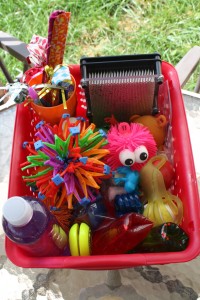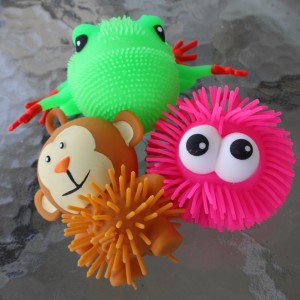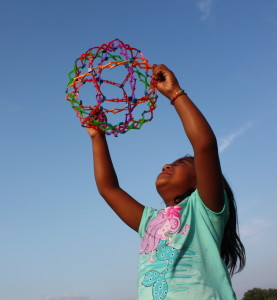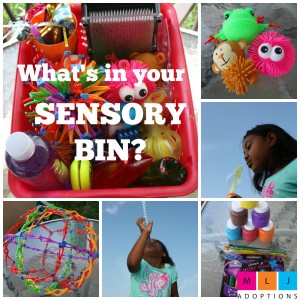 Sensory bins come in all different shapes and sizes, can have many different items in them, and they will differ depending on your child and the sensory input that they need. A sensory bin can be helpful for any child but particularly children who are fidgety, have a sensory process disorder, ADHD, anxiety or autism. Children who are adopted from hard places may struggle more with sensory processing because one of the major risk factors in developing SPD is trauma. Carol Kranowitz, author of The Out-of-Sync Child, explains that Sensory Processing Disorder (SPD) is “the inability to use information received through the senses in order to function smoothly in daily life.” Kranowitz gives many suggestions of sensory activities to help your child stay In-Sync. A sensory bin is just one idea to help a child with tactile sensory needs.
Sensory bins come in all different shapes and sizes, can have many different items in them, and they will differ depending on your child and the sensory input that they need. A sensory bin can be helpful for any child but particularly children who are fidgety, have a sensory process disorder, ADHD, anxiety or autism. Children who are adopted from hard places may struggle more with sensory processing because one of the major risk factors in developing SPD is trauma. Carol Kranowitz, author of The Out-of-Sync Child, explains that Sensory Processing Disorder (SPD) is “the inability to use information received through the senses in order to function smoothly in daily life.” Kranowitz gives many suggestions of sensory activities to help your child stay In-Sync. A sensory bin is just one idea to help a child with tactile sensory needs.
Why have a sensory bin?
In our house, the sensory bin is available for any of our kids to grab an item out when they need it. Sometimes we may direct a child to go pick out a toy if he or she are seeking out sensory input in non-constructive ways. My daughter in particular loves to touch EVERYTHING, she is a “sensory craver” and our sensory bin is tailored to meet her needs. She has a passion for exploring the world through touch! If you tell her not to touch it she wants to touch it even more. When she is touching something she shouldn’t, for example ALL OF THE THINGS in her brother’s room, we might say to her, “it sure looks like you need to touch things right now, go pick something out of the sensory box to meet your need” or “Let’s find an activity like playing with play-doh, sand or finger painting to keep those busy hands busy.”
 A sensory bin can also be used to help a child learn to calm down or self-regulate. Taking deep breaths can be an important tool to learn for self-regulation. Items such as balloons, blowing bubbles, and blowout party favors can help teach regulated breathing but can also be fun and appealing activity for a child. Stress balls and squishy toys are great to help a child release their stress or anger in a more controlled, constructive manner. The goal is for my children to be able to recognize when they are seeking sensory input and teach them to go get a sensory object to meet their need.
A sensory bin can also be used to help a child learn to calm down or self-regulate. Taking deep breaths can be an important tool to learn for self-regulation. Items such as balloons, blowing bubbles, and blowout party favors can help teach regulated breathing but can also be fun and appealing activity for a child. Stress balls and squishy toys are great to help a child release their stress or anger in a more controlled, constructive manner. The goal is for my children to be able to recognize when they are seeking sensory input and teach them to go get a sensory object to meet their need.
What to include in a sensory bin?
My sensory box is geared more toward the school-aged child but you will want to fill yours according to the ages and sensory needs specific to your children. Many items in my sensory bin I was able to purchase at the dollar store. In my house the favorite items are the blowout party favors, slap bracelets, balloons, pin-art toy, homemade stress balls, slippery water tubes, expandable magic ball, and squishy squeeze toys. Everyone has different preferences on what toys they like the best. For example, when we made homemade stress balls we filled some with flour and others with sand. Some members of our family prefer the soft and easily squishy feel of the flour-filled balls while others prefer the rough texture and harder to form sand-filled balls.
Beyond the box
 To help my children meet all of their sensory needs I need more than just a box filled with fun toys and not all of my sensory toys “fit in a box,” so to speak. Here are some examples of items to help meet other sensory needs:
To help my children meet all of their sensory needs I need more than just a box filled with fun toys and not all of my sensory toys “fit in a box,” so to speak. Here are some examples of items to help meet other sensory needs:
- Proprioceptive input: exercise ball, mini trampoline, jump rope, weighted blanket, and hula hoop.
- Vestibular input: swing and sit and spin.
- Oral input: chewelry, sugar-free gum, and hard candies, such as suckers, and crushed ice.
- Smelling input: lotions, essential oils, citrus, and peppermint.
- Auditory input: listen to nature sounds, music and audio books.
- Visual input: lava lamp, time-out timer, light bright, disco ball, or sensory liquid tubes.
These are just a few suggestions of ways to help your child explore their different senses and every child can benefit from exploring their world by using their different senses. For more suggestions of sensory toys based on specific need visit this website.
While sensory boxes can help with tactile sensory exploration each child has a unique set of sensory needs and should have a sensory diet that meets their particular needs. If you think that your child might have a Sensory Processing Disorder contact an Occupational Therapist, who specializes in sensory processing issues, and they can work with your child to develop a sensory diet that can help your child with his or her specific needs. The book The Out of Sync Child gives guidance to parents and includes questionnaires to help parents identify SPD, but ultimately an Occupational Therapist will be best able to evaluate and provide ongoing therapy to best meet your child’s needs.

